Microsoft ends support for Internet Explorer on June 16, 2022.
We recommend using one of the browsers listed below.
- Microsoft Edge(Latest version)
- Mozilla Firefox(Latest version)
- Google Chrome(Latest version)
- Apple Safari(Latest version)
Please contact your browser provider for download and installation instructions.
March 9, 2020
Nippon Telegraph and Telephone Corporation
World’s first transpacific-class transmission experiment employing mode-multiplexed optical signals
-Key achievement for future high-capacity optical transport network infrastructure supporting the spread of 5G and IoT services-
Nippon Telegraph and Telephone Corporation (President: Jun Sawada, Chiyoda-ku, Tokyo, hereinafter NTT) has succeeded in the world’s first transpacific- long-distance optical transmission experiment using multiple spatial modes of an optical fiber.
In recent years, research and development on spatial division multiplexing (SDM) technology has been progressing as a fundamental technology for realizing next-generation optical communication systems. Mode-multiplexed transmission technology, which is one promising enabler for future SDM systems, allows signals to be multiplexed onto multiple spatial modes in an optical fiber, and thus increases transmission capacity accordingly. On the other hand, signal waveform distortion, which is inherent in mode-multiplexed transmission and accumulated with increased distance, has become a major obstacle in achieving long-distance transmission.
In order to offset above issues, we have proposed a novel transmission technique (i.e., cyclic mode-group permutation) that enables ultra-long-haul mode-multiplexed transmission. By applying this technique, we demonstrated the feasibility of a high-capacity, long-distance optical communication system that can expand the transmission capacity by up to six times in comparison with existing fiber-optic communication systems. Moreover, by introducing flexiblity in designing spatial multiplicity, we also demonstrated the world-first transpacific-class mode-multiplexed transmission over 9000 km. In the future, we will continue to study these technologies for the realization of the high-capacity optical transport network infrastructure that supports NTT’s IOWN *1 concept.
Technical details of this achievement will be presented on March 12 (local time) as the Top-Scored Paper *2 in the transmission section at OFC 2020 (The Optical Networking and Communication Conference & Exhibition), the largest international conference on optical communications to be held in North America in San Diego, USA.
Research Background
With the rapid penetrations of 5G services and Internet of Things (IoT) devices, the traffic demand for communications continues to increase in recent years. On the other hand, it is apparent that we have encountered the physical limit of transmission capacity of optical communication systems based on existing single-mode optical fibers (SMFs) in the near future, as is well known as Capacity Crunch *3 . In order to avoid the Capacity Crunch, spatial division multiplexing (SDM) technology is attracting attention as a one of the most important breakthrough technologies for realizing next-generation optical communication systems. By utilizing new optical fibers with multiple cores and/or spatial modes as transmission media, SDM technology is expected to dramatically enhance transmission capacity.
Mode-multiplexed transmission technology that utilizes multiple spatial modes in a multimode optical fiber, which is being researched and developed as a promising enabler in realizing SDM systems, can increase the number of spatial channels by designing fiber parameters and increase transmission capacity accordingly. On the other hand, signal pulses propagated over a multimode fiber have different velocities depending on each spatial mode — known as mode dispersion phenomenon — distorts signal waveforms. Therefore, it is necessary to remove this distortion by means of digital signal processing technique when the information symbol is accurately extracted from the transmitted signal pulses at receivers. Since the total amount of mode dispersion accumulates in proportion to the distance, and it required the huge increases in the computational complexity of signal processing. Therefore it has been a main limiting-factor in achieving the ultra long-haul mode-multiplexed optical transmission.
Summary of Achievements
Figure 1 shows the progress in long-distance transmission experiments using multimode optical fibers and the positioning of this achievement. NTT has developed a cyclic mode-group permutation technique that significantly reduces the impact of the mode dispersion accumulation in mode-multiplexed optical transmission. Using this technique, we succeeded in demonstrating the world’s longest six-mode-multiplexed optical transmission experiment with the distance of 3250 km, which had previously been difficult to achieve (“This work: 12×12 MIMO” in Figure 1). The achieved distance corresponds to that of an ultra-long terrestrial transmission system. In addition, by combining this technology with spatial-mode diversity transmission that can flexibly design spatial multiplicity, we have demonstrated for the first time in the world that achievable transmission reach can be extended up to 9000 km, corresponding to a transpacific-class mode-multiplexed optical signal transmission (“This work: 4×12 MIMO ” in Figure 1).
In both of the above results, the spectral efficiency *4 per spatial mode was 3.0 bit/s/Hz. In particular, in the case of 6-mode-multiplexed transmission, the aggregated spectral efficiency as a mode-multiplexed optical signal reached 18 bit/s/Hz, indicating the possibility of expanding the capacity per optical fiber by six times compared with the existing SMF-based systems.
 Fig.1 Progress in long-distance transmission using multimode optical fibers and positioning of this work
Fig.1 Progress in long-distance transmission using multimode optical fibers and positioning of this work
Detail of Achievements
1. Proposal of Cyclic Mode-Group Permutation Technique to Enable Long Distance Transmission of Mode -Multiplexed Optical Transmission
Figure 2 shows the conventional issues and the effects brought by the proposed technique in a mode-multiplexed optical transmission system. In mode-multiplexed optical transmission, different data streams are multiplexed onto each spatial mode, which is expected to increase the transmission capacity compared to conventional SMF-based systems. On the other hand, since the optical characteristics of each spatial mode differ, transmission performance of mode-multiplexed optical signals represents different behavior. Therefore, mitigation technique for such performance variations becomes an important aspect for realizing future mode-multiplexed optical transmission systems. One main origin of this variation is the mode dispersion phenomenon. Because of this phenomenon, the signal pulse velocity varies depending on the spatial mode, yielding the distorted signal waveform. Therefore the computational complexity of receiver-side signal processing becomes much larger than that of a system using SMFs. The effect of this mode dispersion phenomenon increases in accordance with the transmission distance and the number of modes, which has become a bottleneck in increasing the capacity and distance of mode-multiplexed optical transmission.
In this study, we proposed a cyclic mode-group permutation technique that sequentially exchanges spatial modes taking into account the optical properties of each spatial mode. The application of this technique reduces the performance difference of mode-multiplexed optical signals depending on spatial modes, enabling long-distance transmission. In addition, this technology can be easily implemented as a functional block inside the optical amplifier repeater. By an integrated design with the optical amplifiers, excessive insertion loss of a mode multiplexer/demultiplexer can be also avoided.
 Fig. 2 Conventional Issues in Mode-Multiplexed Optical Transmission Systems and the of Proposed Techniques
Fig. 2 Conventional Issues in Mode-Multiplexed Optical Transmission Systems and the of Proposed Techniques
Figure 3 shows the functional block diagram of the cyclic mode-group permutation unit. In the cyclic mode-group permutation technique, a mode-multiplexed optical signal is first converted into a plurality of fundamental-mode optical signals. Next, these multiple optical signals are grouped into some mode groups based on the optical characteristics before mode demultiplexing, and are interchanged with mode-group granularity. Finally, these fundamental-mode optical signals are again converted into mode-multiplexed optical signals. Since this interchange is assumed to be performed at each transmission span, signal pulses are carried in all spatial modes after transmissions over multiple spans. In addition, this permutation stimulates inter-mode coupling process during optical fiber propagation, which is expected to mitigate transmission performance difference of mode-multiplexed signals.
 Fig. 3 Functional block diagram of the cyclic mode-group permutation unit
Fig. 3 Functional block diagram of the cyclic mode-group permutation unit
2. World’s longest transmission of mode-multiplexed optical signals
We constructed an experiment setup for mode-multiplexed optical transmission using six spatial modes, and evaluated this technique. Using a six-mode optical fiber with a graded index refractive index profile, a mode dispersion coefficient of 70.5 ps/km (@ 1500 nm), and a loss coefficient of > 0.29 dB/km (@ 1500 nm), we conducted a mode-multiplexed optical transmission experiment employing ten-wavelength-multiplexed signals. By applying the cyclic mode-group permutation technique, we confirmed that the signal pulse spread originated from the accumulated mode dispersion was significantly suppressed. In particular, after transmission over distances of 1000 km, a suppression in signal pulse spread of 70% or more was achieved compared with conventional mode-multiplexed transmission. The results suggest that the computational complexity for digital signal processing can be reduced by more than 70% compared to conventional transmission. In addition, after transmission over 3250 km, we confirmed good signal characteristics that exceeded the error correction threshold at all wavelength channels. This result demonstrates a feasibility of a high-capacity, long-distance optical communication system that can expand the transmission capacity of existing fibers by up to six times.
In this study, we also examined spatial-mode diversity optical transmission in order to further increase the distance of mode-multiplexed optical transmission. Figure 4 shows the concept of spatial-mode diversity optical transmission. In N mode-multiplexed transmission using N spatial modes, the system capacity can be scaled up to N times by multiplexing N independent data streams. On the other hand, in spatial-mode diversity optical transmission, by introducing flexibility in designing the spatial multiplicity with the number of data streams less than N to obtain diversity gain, it is possible to further extend the signal transmission distance while using the same optical fiber.
 Fig. 4 Properties of Spatial-Mode Diversity Optical Transmission
Fig. 4 Properties of Spatial-Mode Diversity Optical Transmission
In this study, using the 6-mode optical fiber as the transmission medium, we evaluated performances of optical signal transmission using spatial-mode diversity optical transmission with three different spatial multiplicities of six (225 Gbit/s per wavelength channel), three (113 Gbit/s per wavelength channel), and two (75 Gbit/s per wavelength channel). By flexibly setting of the spatial multiplicity using spatial-mode diversity optical transmission technique, it became possible to dramatically increase the distance of mode-multiplexed optical transmission, achieving mode-multiplexed long-distance optical transmission of 4000 km for the spatial multiplicity of six, 6600 km for the spatial multiplicity of three, and 9000 km for the spatial multiplicity of two, respectively. In particular, through the successful demonstration of mode-multiplexed optical transmission over a distance of 9000 km, we have demonstrated the first-ever transpacific-class mode-multiplexed long-distance optical transmission.
Future Prospects
The technical details of this achievement will be presented on March 12 as the Top-Scored Paper in the digital transmission systems category of the international conference OFC 2020. In addition, NTT has demonstrated the controllability of spatial mode characteristics for the first time in the world by designing the optical fiber cable structure, which will also be presented as a Top-Scored Paper in the fiber and propagation physics category of the same international conference on March 9 *5.
As a next step, we will continue to study these technologies for the realization of the high-capacity optical transport network infrastructure that supports the IOWN concept proposed by NTT in cooperation with relevant technologies that are important in constructing optical communication systems, such as optical fiber cable technologies and optical amplification technologies.
Glossary
- IOWN
Future communication infrastructure based on the latest optical and information technology for realizing smart world. Please see more detail: http://www.iowngf.org - Top-Scored Paper
Among the all submitted papers in one category of the international conference, a paper which acquired the highest average score by all committee members. It means that the paper provides latest and valuable research results in the corresponding research field. - Capacity crunch
An event in which the communication demand exceeds the physical limit of the capacity provided by the optical communication system. In the case of a long-distance optical communication system using SMF, this limit is estimated to be around 100 Tbit per second per optical fiber. - Spectral efficiency
An efficiency to carry information per Hz. The net information rate of the signal is obtained by multiplying spectral efficiency with the signal bandwidth. - World’s First Attempt at Optical Transmission Property Control by Optimizing Optical Cable Structure
- -Milestone for Realizing Long-haul and Large-capacity Mode-multiplexing Optical Transmission Links-
https://group.ntt/en/newsrelease/2020/03/09/200309a.html - -Milestone for Realizing Long-haul and Large-capacity Mode-multiplexing Optical Transmission Links-
Contact Information
Nippon Telegraph and Telephone Corporation
Press Relations
ntt-cnr-ml@hco.ntt.co.jp
Information is current as of the date of issue of the individual press release.
Please be advised that information may be outdated after that point.
NTT STORY
WEB media that thinks about the future with NTT










